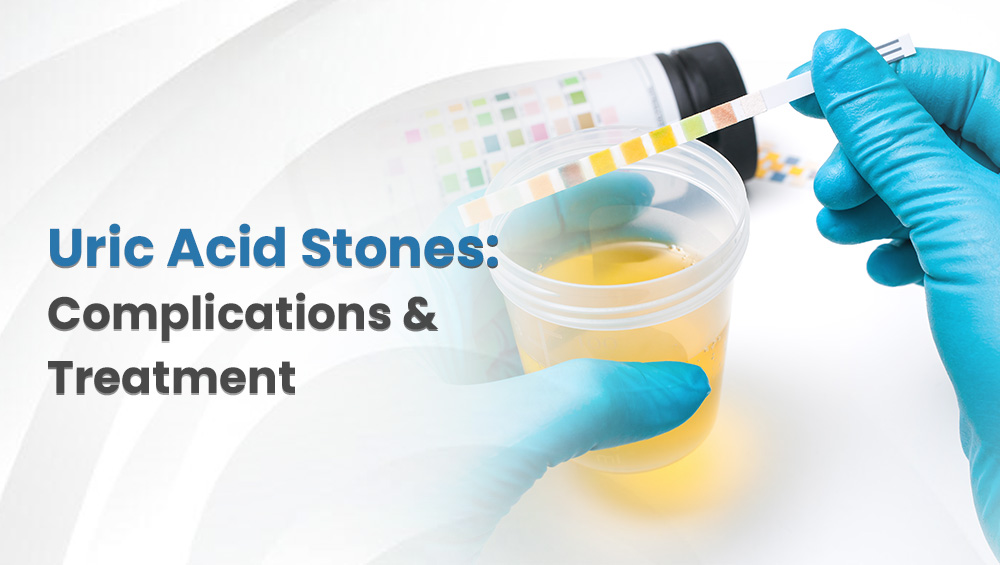Uric acid stones are a common type of kidney stone that can cause significant health issues if not managed effectively. These stones are usually due to high levels of uric acid in the urine and often occur when people have acidic pee or they don’t drink enough water. It can also happen if you eat a lot of purine-rich foods like red meat and seafood too. If the uric acid is not dissolved well, it can come out in crystalline form which forms stones in the urinary tract that may cause great discomfort.
But diagnosing and managing uric acid stones is not as simple when compared to other types of kidney stone formations. They are usually mistaken for ordinary back pain and urinary tract symptoms so often the diagnosis is made late. Moreover, there is a risk that if these stones become larger in size or form more than one they may occlude the kidneys (or bladder) and create life threatening complications.
In this blog we will list the symptoms to look out for, why these stones form and explain the latest treatments and preventive measures that will help you find relief and prevent future episodes.
How Uric Acid Stones Form in Your Body?
Uric acid stones develop when specific conditions in the body lead to high uric acid levels, which then crystallize in the kidneys or urinary tract. Here’s a detailed breakdown of how this process unfolds:
- Excessive Uric Acid Production
- Uric acid is a waste product formed when the body breaks down purines, which are found in many foods (like red meats, seafood, and alcohol).
- People with diets high in purines or who have certain genetic predispositions may produce excessive uric acid, increasing the chances of stone formation.
- Inability to Excrete Uric Acid Properly
- The kidneys filter out waste, including uric acid, through urine.
- When the body produces more uric acid than the kidneys can excrete, uric acid levels rise, causing it to accumulate and possibly crystallize.
- Acidic Urine Environment
- Uric acid is less soluble in acidic urine, so when urine pH is consistently low (more acidic), uric acid crystals form more readily.
- Dehydration and certain metabolic disorders can lead to acidic urine, creating a more favorable environment for stone formation.
- Crystal Formation and Aggregation
- Excess uric acid crystallizes in the urine, forming small particles.
- These crystals can stick together, eventually forming larger stones that can obstruct the urinary tract, leading to pain and other symptoms.
- Risk Factors for Uric Acid Stones
- Dietary Habits: High intake of purine-rich foods, alcohol, and sugary drinks can increase uric acid production.
- Dehydration: Reduced water intake or conditions that cause excessive fluid loss can concentrate urine, creating an ideal environment for stone formation.
- Obesity and Metabolic Syndrome: These conditions are linked to increased uric acid levels and low urine pH, raising the risk for uric acid stones.
- Genetic Predisposition: Family history of uric acid stones or gout increases one’s susceptibility to forming them.
Uric acid stones are highly preventable with lifestyle adjustments, proper hydration, and sometimes medication, so knowing these causes can be a first step toward managing or preventing their formation.
What are the Complications of Uric Acid Stones?
If not treated promptly, uric acid stones can lead to various health complications, many of which may impact kidney function and overall well-being. Here’s a look at the key complications associated with uric acid stones:
- Urinary Tract Obstruction: Uric acid stones can block the flow of urine, especially if they move from the kidneys into the ureter (the tube that connects the kidney to the bladder). Obstruction can lead to intense pain, known as renal colic, and may cause pressure buildup in the kidneys, which can impair kidney function over time.
- Infection and Pyelonephritis: Blockages created by uric acid stones increase the risk of urinary tract infections (UTIs), as they can trap bacteria in the urinary system. In severe cases, infections can ascend to the kidneys, leading to pyelonephritis (kidney infection), which requires immediate medical attention to avoid kidney damage.
- Kidney Damage: Persistent blockage and infection can cause irreversible damage to the kidney tissues, potentially leading to scarring and reduced kidney function. Over time, if multiple stones form or obstructions are recurrent, this can lead to chronic kidney disease (CKD).
- Hydronephrosis: Hydronephrosis is the swelling of one or both kidneys due to urine buildup when a stone blocks the urinary tract. This condition can lead to stretching of the kidney tissues, further impairing function and increasing the risk of kidney infections and tissue damage.
- Pain and Quality of Life Issues: Large or obstructive uric acid stones often cause severe, sudden pain (renal colic), which can significantly impact a person’s quality of life. Chronic pain from recurrent stones or infections can lead to reduced mobility and psychological stress, especially if stones form frequently.
- Hematuria (Blood in Urine): Stones that rub against the urinary tract lining can cause bleeding, resulting in blood in the urine (hematuria). While often not severe, hematuria can indicate ongoing irritation or inflammation in the urinary tract.
- Potential for Recurrence: Uric acid stones have a high rate of recurrence, especially if dietary and lifestyle changes aren’t implemented. Recurrence leads to increased risks of the aforementioned complications over time, making prevention crucial for long-term health.
Taking steps to manage and prevent uric acid stones is essential to avoid these complications, from dietary changes to medication and regular monitoring. Early intervention can help protect kidney function and improve overall health outcomes.
How Are Uric Acid Stones Treated or Removed?
Treating uric acid stones involves a combination of lifestyle changes, medications, and, if necessary, medical procedures. The main goal is to dissolve existing stones, prevent new ones from forming, and relieve symptoms. Here’s a breakdown of treatment options for uric acid stones:
Medications
- Alkalizing Agents (e.g., Potassium Citrate or Sodium Bicarbonate): These medications help make urine more alkaline, which can dissolve existing uric acid stones and prevent new ones from forming.
- Allopurinol: Used to lower uric acid levels in the blood, allopurinol is especially useful for people with high uric acid due to medical conditions like gout.
- Pain Relievers: For those with discomfort from stone passage, over-the-counter or prescription pain relievers may be recommended to manage pain during treatment.
Surgical Procedures
- Extracorporeal Shock Wave Lithotripsy (ESWL): This non-invasive procedure uses sound waves to break up larger uric acid stones into smaller fragments, which can then be passed more easily in urine.
- Ureteroscopy and Laser Lithotripsy: For stones that are lodged in the ureter or too large to pass on their own, a ureteroscopy procedure can be performed. A small tube with a camera (ureteroscope) is inserted into the urethra to locate the stone, and laser energy is used to break it up.
- Percutaneous Nephrolithotomy (PCNL): For very large stones, PCNL is a minimally invasive procedure where the stone is removed through a small incision in the back. This is typically a last resort when other treatments aren’t effective.
- Retrograde Intrarenal Surgery (RIRS): RIRS involves using a flexible ureteroscope that is inserted through the urethra, bladder, and up into the kidney to access the stone directly. Once the stone is located, a laser fiber is used to fragment it into small particles that can be naturally passed out in the urine.
Why is RIRS Best for kidney stone treatment?
Below are the reasons why RIRS is the top treatment option for uric acid stones:-
- Minimally Invasive: RIRS is conducted without any incisions, making it a minimally invasive option compared to more traditional surgical methods.
- Quick Recovery: Patients generally recover faster than with open or percutaneous surgeries, with a shorter hospital stay and minimal post-operative pain.
- High Precision: RIRS provides high-definition visualization, allowing precise stone fragmentation and minimal disruption to surrounding tissues.
RIRS is especially useful for patients with stones in hard-to-reach areas of the kidney, or those with smaller to medium-sized stones that are not effectively treated with shock wave lithotripsy (SWL) or for patients who prefer a faster recovery over more invasive procedures.
RIRS, along with other advanced techniques like ESWL, ureteroscopy, and percutaneous nephrolithotomy, provides effective and minimally invasive options for the removal of uric acid stones, making it easier for patients to manage their condition and recover swiftly.
CureStone: Your Go-To for Kidney Stones
At CureStone, we understand that kidney problems can be challenging. That’s why we are here to help you find relief and lasting solutions. We don’t just address your current kidney stone issues; we also focus on preventing them from returning. From your first visit to your recovery, our experts guide you every step of the way, providing comprehensive care to minimize pain and help keep you stone-free. Reach out to us today for expert care and guidance. Together, we’ll pave the way to a healthier, pain-free future, while confidently preventing future stones.

